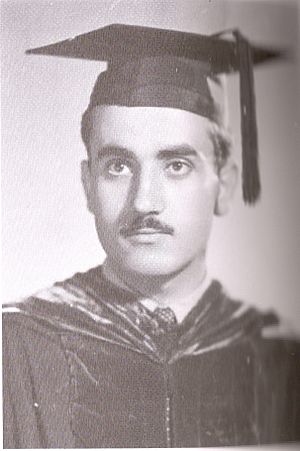George Habash facts for kids
Quick facts for kids
George Habash
جورج حبش |
|
|---|---|
 |
|
| Secretary-General of the Popular Front for the Liberation of Palestine | |
| In office December 1967 – July 2000 |
|
| Succeeded by | Abu Ali Mustafa |
| Personal details | |
| Born | 2 August 1926 Lydda, British Mandate of Palestine |
| Died | 26 January 2008 (aged 81) Amman, Jordan |
| Political party | Popular Front for the Liberation of Palestine (1967–2008) Arab Nationalist Movement (1951–1967) |
| Alma mater | American University of Beirut |
George Habash (Arabic: جورج حبش), also known as "al-Hakim" (meaning "the wise one" or "the doctor"), was a Palestinian Christian politician. He was born on August 2, 1926, and passed away on January 26, 2008. He founded a major political group called the Popular Front for the Liberation of Palestine (PFLP). This group was known for its left-wing and secular (non-religious) nationalist ideas. Habash led the PFLP as its Secretary-General until 2000, when he stepped down due to health reasons.
Contents
Early Life and Education

George Habash was born in 1926 in Lydda (now called Lod). His family belonged to the Eastern Orthodox Church. As a child, he sang in the church choir.
In 1948, while Habash was studying medicine at the American University of Beirut, a war broke out. His hometown, Lydda, was captured, and many Arab residents, including his family, had to leave. They became refugees and could not return home. This event deeply affected Habash and shaped his political views.
After finishing medical school in 1951, Habash worked in refugee camps in Jordan. He also ran a clinic with his friend, Wadie Haddad. Habash strongly believed that the state of Israel should be changed, and he supported strong actions to achieve this.
Forming Political Groups
In 1951, George Habash started the Arab Nationalist Movement (ANM). He wanted to unite the Arab world to support the Palestinian cause. The ANM was inspired by Gamal Abdel Nasser's ideas of Arab nationalism.
Habash faced political challenges in Jordan. In 1957, he was involved in political unrest and had to go into hiding. He later moved to Syria and then Beirut. He was a key member of the Palestine Liberation Organization (PLO) for a time. However, he later felt sidelined by Yasser Arafat, another important Palestinian leader.
The Popular Front for the Liberation of Palestine
After the Six-Day War in 1967, many people felt disappointed with the political situation. This led Habash to create the Popular Front for the Liberation of Palestine (PFLP) on December 11, 1967. He became its first leader.
The PFLP adopted left-wing political ideas. It aimed to create a single, secular, and democratic state in Palestine where all people could live together. The group strongly believed that Israel should not exist in its current form.
The PFLP became known for its determined actions. The group carried out actions, like taking over airplanes, to draw worldwide attention to their goals. These actions made the PFLP and the Palestinian issue famous around the world. However, these actions also caused disagreements with other Palestinian groups.
Major Events and Later Life
In 1970, Habash had to leave Jordan because of the PFLP's role in the Black September events. This was a period of intense conflict between Palestinian groups and Jordanian forces. The conflict led to many Palestinian fighters moving to Lebanon.
In 1974, the Palestinian National Council (PNC) discussed a plan for two separate states (one Israeli, one Palestinian). Habash disagreed with this idea. He formed a group called the Rejectionist Front with other parties who also opposed the two-state solution.
Habash's health began to decline after a stroke in 1980. Other members of the PFLP started to take on more leadership roles.
After the Oslo Peace Accords were signed in 1993, Habash again strongly disagreed with Yasser Arafat. He felt that the agreements did not serve the Palestinian cause. He formed a new alliance with other groups, including Hamas.
In 2000, George Habash resigned from his leadership role in the PFLP due to poor health. Abu Ali Mustafa took over as the new leader. Habash continued to be involved in the group's activities until his death. Many Palestinians respected him for his strong beliefs and his commitment to his principles.
Death and Legacy

George Habash passed away on January 26, 2008, at the age of 81, from a heart attack in Amman, Jordan. The President of the Palestinian National Authority, Mahmoud Abbas, declared three days of national mourning.
Habash was buried in a cemetery in Amman. Mahmoud Abbas called him a "historic leader" who fought for the rights of his people. Other Palestinian leaders, including Ismail Haniyeh of Hamas, also sent their condolences, recognizing Habash's long struggle for Palestine.
See also
 In Spanish: George Habash para niños
In Spanish: George Habash para niños

